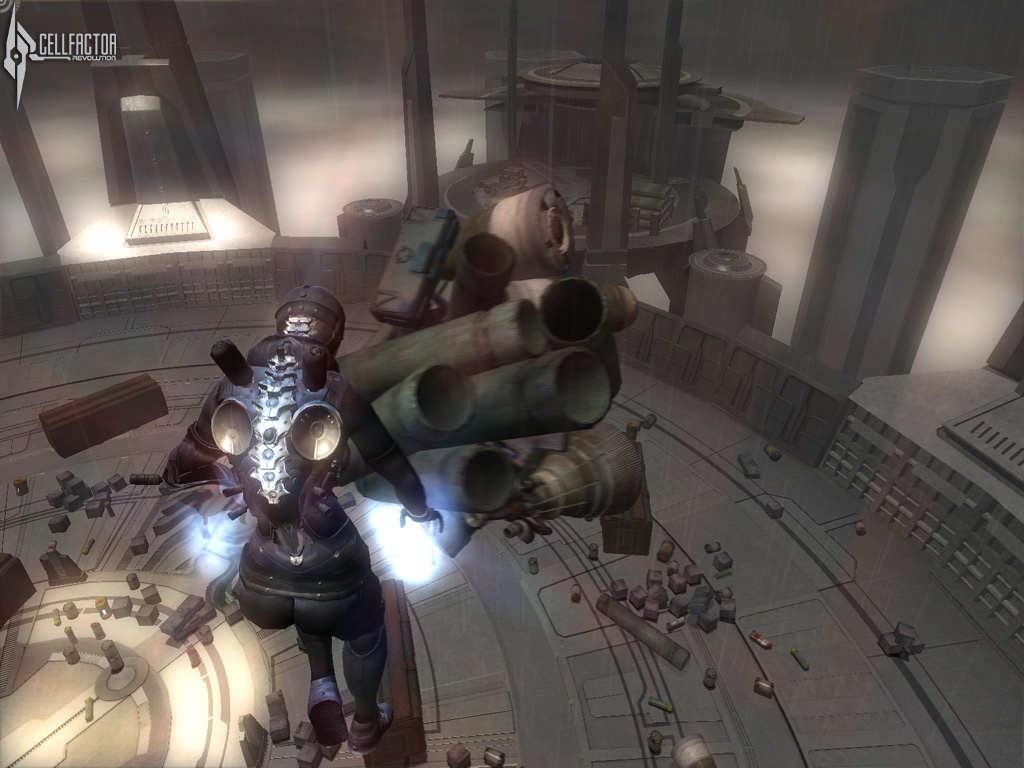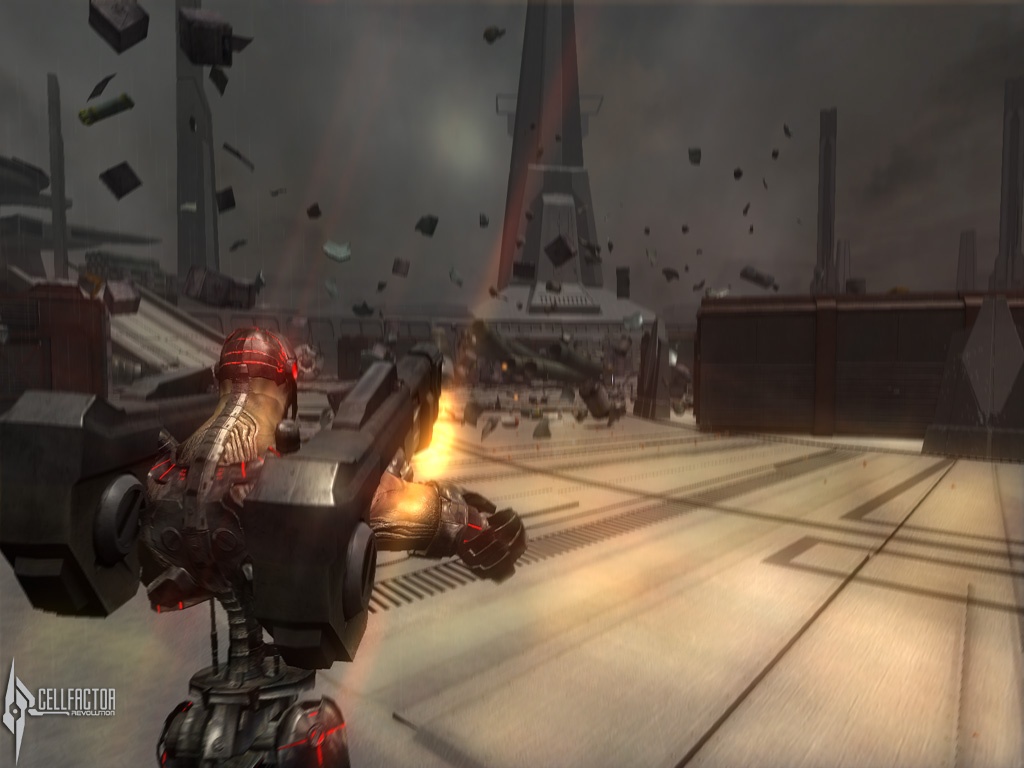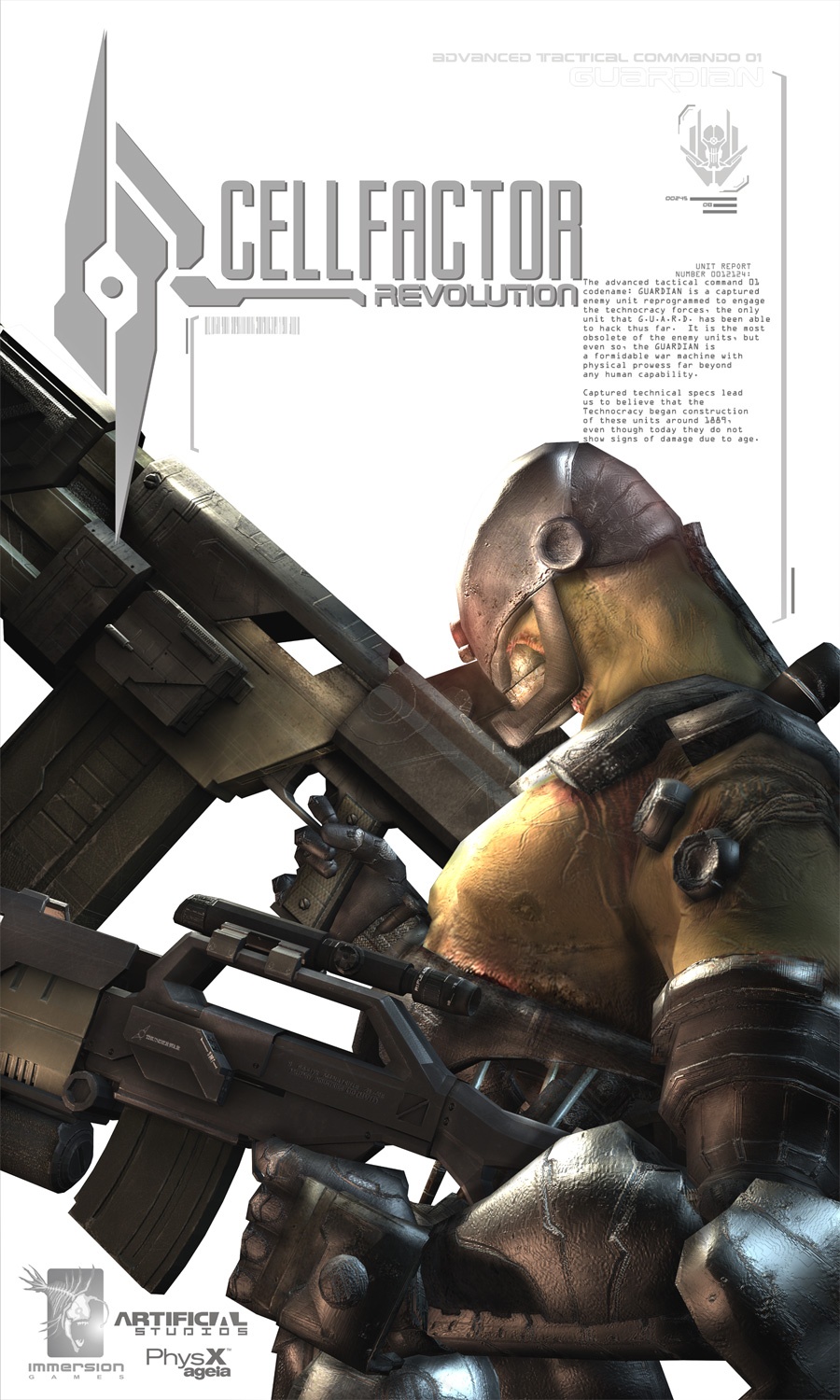CellFactor: Revolution Q&A - Physics, Characters, Story, and Psychic Powers
This physics-heavy action game will offer first-person shooting action and psychic powers that will let you smash the landscape to bits. We've got updated details.
There was a time when action games put you in static worlds, where the only things you could affect were enemies you could shoot; keycards you could pick up; and maybe, if you were lucky, barrels you could explode with a few well-placed gunshots. Thanks to the miracle of modern science, computer games now offer much more interactivity; you can blow up chunks of your environments and toss them all over the place thanks to advanced-physics programming--including the physics supported by hardware manufacturer AGEIA's "PhysX" chip.

One game that got some attention at this year's Electronic Entertainment Expo for its use of physics was CellFactor, a technical demonstration that will now be coming home to the PC as a new game called CellFactor: Revolution. Artificial Studios' president and lead developer Jeremy Stieglitz sat down with us to give us an update on this sci-fi shooter that will let you shoot, run, and tear up your surroundings.
GameSpot: We understand that CellFactor started out as a tech demo using AGEIA's PhysX technology. Tell us about how the demo eventually ended up becoming a full-fledged game product.
Jeremy Stieglitz: In January of this year, we got our hands on some prototype PhysX hardware. We decided to use what limited resources we had at the time--Artificial is a small, independent developer--to put together a uniquely styled first-person shooter demo. We thought development of CellFactor would end there, but to our surprise, the gaming community seemed genuinely interested in the concepts in the demo, so we managed to secure some backing to put together a full multiplayer PC game. Our goal at the time was to produce CellFactor: Revolution without affecting our other title in development, Monster Madness, and the solution has been to create a second team at Artificial to develop it.
GS: Tell us about the game's use of advanced physics--just how much of the game's environments can be moved and deformed? Will manipulating the environment be a big part of gameplay?
JS: In the tech demo [shown at E3], there are several thousand rigid-body objects within the environment that can be used as weapons, and there are some cloth and fluid elements, but beyond that, you're basically in a static environment. Not so for Revolution. Our goal for this game is now to make the environment as interactive as the objects within it, and our primary way of doing that is to construct architecture from breakable-jointed dynamic objects rather than static geometry (as was done in the tech demo). This allows explosions to shatter stairwells, psychic powers to collapse pillars (the debris from which can then be used as weapons), gunfire to chip pieces off concrete, and all manner of environmental destruction. The downside is that joints are very complex computations, so the performance difference between software and PhysX hardware is more extreme. Thus, we find that some environments simply don't run in software anymore, but that's a worthy trade-off for the havoc you can unleash on a destructible environment. It really makes some of the psychic powers rather insane to see in motion, as everything around you collapses and shatters.
GS: Is the game being developed mainly for users that will hopefully have purchased high-end computers with physics-accelerator hardware by the time the game ships? What kind of hardware specs are you targeting?

JS: The primary target user will have PhysX hardware, and a portion of the game's content will require that the hardware is present on the system. The game's content will still be accessible to users in software physics, but that will be limited to environments without the robust interactivity of the hardware levels. As far as graphics go, the sheer number of objects onscreen pretty much requires a GeForce 6800 or ATI X800 generation video card, but if you have a GeForce 7900 or ATI X1900, you can crank up the high dynamic range lighting, per-pixel motion blur, and texture resolution to enjoy some eye candy along with your physics. CPU requirements are not as great, since much of the most intensive calculations are off-loaded to the PhysX processing unit, so you can capably run the game with a single-core processor with a speed of about 2GHz.
Psychic Hotline
GS: We understand that you'll play as one of three different characters that may have powers that let them lift and hurl objects in the world. At E3, we also saw the character use a power-up item to take flight. Tell us about these characters' background stories and how they came to possess their powers. What are some of the other powers your character will possess?

JS: We wanted to open up the setting and let players choose from different balances between psychic power and weapon combat. To that end, we now have three character classes you can choose from in most of the multiplayer game types. Each of these characters represents a different approach to the game's combat mechanics.
Bishop: An experiment of the secretive Technocracy faction in the CellFactor universe. Though originally human, she's been injected from birth with mind-enhancing drugs and outfitted with cybernetic implants to further boost her abilities. The result is that though she does not wield any weapons, the bishop focuses both hands on projecting psychic power and thus is able to manipulate the world around her on a scale unmatched by the other characters. Some of her abilities include: "psi rift," which lets her gather huge numbers of objects in a gigantic ball; "psi crunch," which basically means she can detonate whatever objects she's holding (including other characters); "psi wave," which allows her to part a "sea" of objects to either side; and "psi shield," which allows her to surround herself with all sorts of nearby objects, creating a natural protective shield. Note that all these abilities rip up the environment, too. So, for example, activating "psi rift" near a structure might collapse it and gather its pieces in a big ball that you can then hurl at your enemies.
Guardian: A cybernetic creature developed by the Technocracy as a primary assault unit. The guardian is not an innately organic creature and thus does not possess any psychic abilities whatsoever. To compensate for this deficiency, the guardian can wield any two weapons at once. This includes heavy weapons, such as rocket launchers and Gatling guns. He can then use both weapons' primary and secondary firing modes simultaneously or independently, as he sees fit. Furthermore, the guardian has incredible strength, allowing him to leap hundreds of feet into the air and (optionally) pound the ground to create a gigantic shockwave. He can also unleash a variety of devastating punches (when carrying only one weapon), which can send objects flying or instantly kill any player. Effectively, the guardian is ideal for players that find all this psychic power to be a little too subtle and prefer the direct approach of massive firepower.
Black Ops: The standard unit of the human resistance, the black ops soldier is an elite unit who has undergone psychic enhancement from captured Technocracy equipment. The black ops is basically the character featured in CellFactor: Combat Training, who wields a gun in one hand and psychic power in the other. This strikes a nice balance between weaponry and physical attacks, letting the player determine which combat situation is best for each approach. As you've seen in the tech demo, the black ops soldier can increase his psychic potential by injecting himself with power-ups found in various crates within the environments. (For that matter, so can the bishop.)
GS: Give us a brief overview of the game's story. Who are the characters fighting against, and why?
JS: The world of CellFactor posits a near future in which a secretive military-industrial corporation, known as LIMBO, unleashes a secret force that has devastated the planet. The player characters can either fight as part of this force, known as the Technocracy, or against it with the human resistance. Since this will primarily be a competitive multiplayer game, the storyline is not central to the gameplay, but it hopefully does provide something of a basic context for the action.
GS: What can you tell us about plans for the game's multiplayer? How will the game manage all the complex physics calculations of objects, explosions, and particles online?

JS: The tech-demo game was pretty much LAN-only, since it assumed that the server would have very high bandwidth, reliable messaging, and low ping. With Revolution, we're working to support proper Internet play out of the box. That includes retooling the network code to predict movement properly under high-latency, low-reliability conditions. Those adjustments aren't a problem, but Internet servers with low bandwidth won't be able to send that much real-time physics synchronization data (for thousands of simultaneously moving objects) over the Internet, no matter what we do. So to make the game playable under a wide variety of network conditions, Revolution includes a "physics density" slider for servers, which scales down the number of objects and destructive potential of the environment to accommodate servers with less bandwidth. The game will ship with presets for a wide variety of server configurations, so basically Internet servers of all kinds should be able to host sessions--some with less interactivity than others but all fundamentally the same game.
GS: Finally, is there anything else you'd like to add about the game?
JS: The first-person genre is extremely crowded, so with CellFactor: Revolution, we're working hard to bring something new to the table. Moving away from straightforward my-gun-is-bigger-than-yours combat and more toward innate character abilities is something that I personally enjoy very much--it makes me feel like I'm actually playing as a seriously powerful character--and I hope others do, too!
GS: Very cool. Thanks, Jeremy.
Got a news tip or want to contact us directly? Email news@gamespot.com
Join the conversation